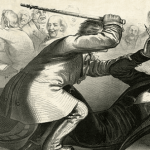 Technology
Technology  Technology
Technology  Humans
Humans 10 Everyday Human Behaviors That Are Actually Survival Instincts
 Animals
Animals 10 Animals That Humiliated and Harmed Historical Leaders
 History
History 10 Most Influential Protests in Modern History
 Creepy
Creepy 10 More Representations of Death from Myth, Legend, and Folktale
 Technology
Technology 10 Scientific Breakthroughs of 2025 That’ll Change Everything
 Our World
Our World 10 Ways Icelandic Culture Makes Other Countries Look Boring
 Misconceptions
Misconceptions 10 Common Misconceptions About the Victorian Era
 Mysteries
Mysteries 10 Strange Unexplained Mysteries of 2025
 Miscellaneous
Miscellaneous 10 of History’s Most Bell-Ringing Finishing Moves
 Technology
Technology Top 10 Everyday Tech Buzzwords That Hide a Darker Past
 Humans
Humans 10 Everyday Human Behaviors That Are Actually Survival Instincts
 Animals
Animals 10 Animals That Humiliated and Harmed Historical Leaders
Who's Behind Listverse?

Jamie Frater
Head Editor
Jamie founded Listverse due to an insatiable desire to share fascinating, obscure, and bizarre facts. He has been a guest speaker on numerous national radio and television stations and is a five time published author.
More About Us History
History 10 Most Influential Protests in Modern History
 Creepy
Creepy 10 More Representations of Death from Myth, Legend, and Folktale
 Technology
Technology 10 Scientific Breakthroughs of 2025 That’ll Change Everything
 Our World
Our World 10 Ways Icelandic Culture Makes Other Countries Look Boring
 Misconceptions
Misconceptions 10 Common Misconceptions About the Victorian Era
 Mysteries
Mysteries 10 Strange Unexplained Mysteries of 2025
 Miscellaneous
Miscellaneous 10 of History’s Most Bell-Ringing Finishing Moves
10 Worst Political Marriages in History
Most royals today are free to marry whomever they please (at least, up to a certain point). But for most of history, marriage was about securing power and wealth, not love.
If you hated your husband from the day you met him, well, too bad! You’re stuck with him for the rest of your life (barring some extreme circumstances you’ll see below). Some people were able to produce an heir and get on with their lives secretly seeing a lover. Others learned to love each other for what they were. But a select few politically-arranged marriages in history didn’t work out for anyone involved.
Here are 10 of the worst political marriages in history.
Related: 10 Scurrilous Royals and Nobles Who Were Involved in Juicy Scandals
10 Philip II and Ingeborg of Denmark
In the 11th century, King Philip II of France sought a way to align himself with Denmark. As France began to build its navy, he worried the Danes’ fierce fleet might attack. So when the opportunity to marry Ingeborg, a Danish princess, came upon him, he pounced.
The two were married in 1193 in the typical celebratory fashion. But that’s where the happiness ends. The morning after their union, Philip suddenly declared he wanted Ingeborg to be sent back home. He couldn’t stand to be near her, much less continue to try for a child.
So, what happened? It’s a question historians have been trying to answer for centuries. Traditionally, the couple would have consummated the marriage. Whether this happened or not is up for debate. Some theorize that Ingeborg refused to have sex with Philip. However, this is unlikely. Did she laugh at him? Did she say something to hurt his feelings? Was her strong constitution simply too much for the king? Did all that Danish herring make her breath smell deadly?
Whatever it was, it cost Ingeborg for the rest of her life. Philip lobbied for an annulment and forced his wife into house arrest for the next decade. Though Philip fought hard to prove the marriage wasn’t valid and openly saw other women, they technically stayed married for the rest of their lives.[1]
9 Enrique IV and Joanna of Portugal
With his first marriage ending in an annulment and no male heir to the throne, Enrique IV of Castile was desperate to marry.
Joanna of Portugal seemed like an ideal candidate, as their union would mean a strong alliance in the Iberian peninsula. With several different factions throughout the area trying to come to power, it was imperative that Enrique show a united front with his new bride, but Joanna was not on board.
Rumors of her adultery and suspiciousness about their son’s legitimacy threw the area into turmoil and ended with a rebellion that overthrew Enrique. Joanna was banished from the royal court and subsequently gave birth to two bastard children, ruining her reputation and ending the royal line.[2]
8 George IV and Caroline of Brunswick
George IV was deeply in debt. British Parliament agreed to increase his salary if he married a suitable Protestant princess, so he quickly scrambled to find a wife.
His cousin Caroline fit the bill, and the two married in haste. Though his debts shrank, his problems multiplied when rumors began to swirl that George had been secretly married to his mistress years before, making his relationship with Caroline invalid.
The rumors were true, though it was never legally recognized by the government due to his lover being Catholic. In addition to George’s previous marriage, the two simply weren’t compatible. George openly complained about Caroline’s hygiene, and she regarded him as ugly.
Their hatred spread so deep it overcame politics. While trying to inform George that Napoleon Bonaparte had finally died, a servant told the king, “Your greatest enemy is dead!” George apparently replied, “Is she?”[3]
7 Louis V and Adelaide-Blanche
Worried that the powerful rival family, the Robertians, would eventually overtake them, King Lothaire of France married his son, Prince Louis, to one of their daughters in 982. Adelaide-Blance was over twenty years older than Louis, and the relationship only lasted two years before being annulled.
Louis died without any heirs, and power was passed down to Hugh Capet, a member of the Robertian family. So, despite King Lothaire’s careful scheming and using his son as a bargaining chip, the family’s influence faded, and eventually, the bloodline ended.
Though it’s already pretty bad to stage a coup that strips your husband of his power, some believe she went even further. Edward would eventually be brutally murdered, and many think that Isabella may have been involved, hoping to give her newly powerful son even more agency.[4]
6 Peter I of Castile and Blanche of Bourbon
Though Peter I of Portugal was happily in love with a woman named Maria de Padilla, his mother was not satisfied. Seeing the opportunity for a strong alliance with France, she orchestrated a marriage between Peter and the niece of the French king, Blanche of Bourbon.
It was clear from the beginning that this was not meant to be. Peter was known for his vicious treatment of enemies (eventually earning him the historical moniker “Peter the Cruel”), while Blanche was known for her sweet disposition. To no one’s surprise, Peter continued his relationship with Maria de Padilla, rendering Blanche humiliated and useless since they had no children.[5]
5 George I and Sophia Dorothea
First cousins George Ludwig and Sophia Dorothea were married at the request of George’s mother, who saw Sophia’s wealth as a way to assure her son’s place in society.
From the beginning, the marriage was tense. But in 1684, it wasn’t really about whether or not you could stand your husband; it was about whether or not you could produce an heir. And Sophia could. So, for years, the two put up with each other.
But eventually, annoyance turned to hatred. They fought bitterly at every turn, and things got out of hand when Sophia began an affair with a Swedish count. She was caught attempting to flee from England with her lover and imprisoned for the last thirty years of her life.
George, of course, had been having affairs the entire time and faced no ridicule or consequences.[6]
4 Henry VIII and Catherine of Aragon
Choosing just one of Henry VIII’s six marriages is difficult for this list. Considering he had two of his wives beheaded and divorced two more, Henry’s historical legacy has not been positive.
However, his first and longest-lasting marriage to Catherine of Aragon is perhaps the worst because it seems there truly was some love and respect in the relationship at some point. For the first years of their marriage, the two were devoted to each other, but Catherine’s inability to have a male heir caused Henry to stray.
But 24 years of marriage meant nothing to Henry, who pursued young Anne Boleyn instead. He famously attempted to have their marriage annulled. The Pope refused. In response, Henry declared himself the Supreme Head of the Church of England and allowed his new archbishop to annul it.
Catherine was no longer allowed to see her daughter—Mary—and was forced to live in remote cottages throughout the country. Though popular opinion was decidedly against Henry for his callous and lusty actions, Catherine lived in disgrace for the rest of her life.[7]
3 Edward II and Isabella
Though it seems crazy to most people today, when Isabella of France married King Edward II at age 12, she was one of many children who were wed to adults for political reasons. With an adult husband, it may seem almost like a blessing that Edward showed little interest in his new wife. Though it wasn’t because of her age.
Edward was much more interested in pursuing his male courtiers like Piers Galveston and Hugh Despenser. His abject favoritism and increasingly tyrannical rule led to general unrest in England. And his neglect of his wife didn’t help their relationship. In 1326, Isabella teamed up with an opposing baron and invaded England, executing the Despensers (Edward’s favorites) and deposing Edward.[8]
2 Henry II and Eleanor of Aquitaine
Perhaps the most famously awful marriage in history, the relationship between Henry II and Eleanor of Aquitaine has been immortalized by the 1968 film The Lion in Winter, where Katharine Hepburn and Peter O’Toole star as the feuding couple.
Eleanor was desperate to marry after her first marriage was annulled. Her land and power could be taken away easily&. Marrying Henry offered her a way to secure these. Unfortunately, it also caused some new problems for England. Eleanor’s thirst for power and refusal to sit quietly by Henry’s side eventually led to a coup in 1173, led by Eleanor’s sons, against the reigning king. Whether her support resulted from political aspirations for herself and her children or a revenge plot due to his public promiscuity is unknown.
Regardless, the plan was a failure. Henry imprisoned Eleanor for the next 16 years. And I’m pretty sure there were no conjugal visits or love lost between the two schemers.[9]
1 Peter III and Catherine the Great
Catherine the Great is remembered as the longest-reigning female in Russian history, as well as for her extensive reforms and intellectual pursuits. She helped usher Russia into a new age that aligned with the modernization of Europe and the Americas.
But in order to get to this point, she had to overcome some obstacles. Namely, her husband.
Peter III and Catherine were married at ages 17 and 16, making this a high school sweetheart story from hell. According to most accounts, Peter was frequently drunk and cruel, as well as childish (but considering he was a child, can we really blame him?). Catherine’s interest in philosophy and politics was not appreciated by her husband, who preferred to spend his time with other women or on military exploits.
With the support of the Russian military, Catherine staged a coup that successfully removed Peter from the throne. He was exiled and died a few days later. Whether it was from hemorrhoids and a stroke, as the official report claims, or Catherine’s orders, is up for debate.[10]








